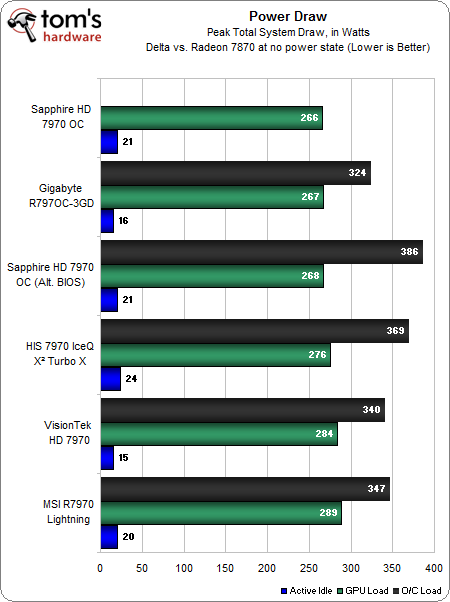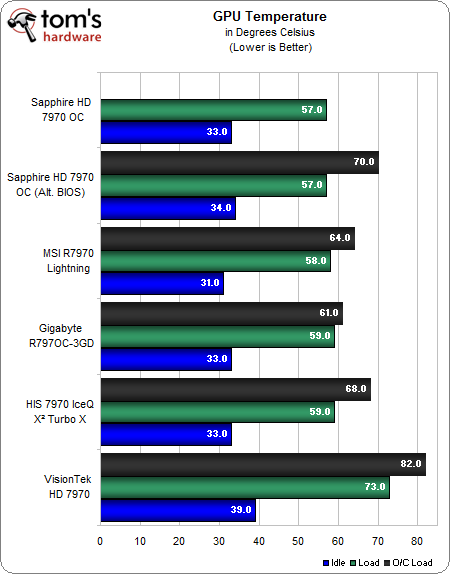Five Radeon HD 7970 3 GB Cards, Overclocked And Benchmarked
GeForce GTX 680 cards are nowhere to be found, and the Radeon HD 7970 recently dropped to a much more attractive price. We thought it was time to round up a handful of Tahiti-based cards to see how board partners are improving upon AMD's original recipe.
Power, Temperature, And Noise
Now that we know it's possible to achieve very similar performance by taking AMD's Tahiti GPU and its GDDR5 memory as far as they'll go, it's equally important to evaluate power use, thermals, and acoustics.
The blue bar represents idle power usage, and the green bar shows load consumption at each card's stock frequencies. There’s a 23 W spread between the contenders under load, likely reflecting a number of factors, including cooling solutions and voltage settings.
The dark grey bar is indicative of power consumption under load of the overclocked configurations. The only real surprise is a relatively high result from Sapphire's board.
Despite an eclectic range of cooling solutions, measured temperatures are quite similar at idle and under load using factory-supplied frequencies. The exception is VisionTek's card, perhaps as a result of its reference heat sink and fan. The rest of the field’s overclocked thermal results mirror the power draw chart.
Noise is a critical consideration when comparing graphics cards with the same GPU, particularly when we consider that AMD's reference implementation was observed to be quite noisy under load back when the card launched.
A majority of today's contenders perform much more admirably, regardless of whether the card is resting idle or working hard under a load. Of course, VisionTek’s board struggles as a result of its reliance on that familiar cooler from AMD. Overclocked and under load, both the Gigabyte and VisionTek cards generate more noise than we'd like, even as the rest of the pack is significantly quieter.
MSI’s Twin Frozr IV performs exceptionally well in this situation, generating slightly more noise than idle under load, and just a tad more than that overclocked.
Get Tom's Hardware's best news and in-depth reviews, straight to your inbox.
Current page: Power, Temperature, And Noise
Prev Page Overclocking AMD's Radeon HD 7970 Next Page Five Radeon HD 7970s; One Rises To The TopDon Woligroski was a former senior hardware editor for Tom's Hardware. He has covered a wide range of PC hardware topics, including CPUs, GPUs, system building, and emerging technologies.
-
aznshinobi I need a new pair of pants. Definitely graphics card eye candy. Specially the Sapphire one IMO. Do I hear giveaway THG?Reply -
schnitter I need to replace my 5870 HD I bought over 3 years ago. I can still play any game on HIGH at 1080p, but I want ULTRA on BF3 and Max Payne 3.Reply
Lets hope the 680 GTX becomes available to see what price these AMD cards end up at. I like AMD and how they don't rebrand their cards like nVidia, but $20 cheaper than 680 GTX is not cheap enough to sway me that way. -
hellfire24 why a reference card(visiontek 7970) with non reference competitors?Reply
i am impressed with HIS IceQ X2 Turbo X but still MSi lightning is my favorite.they have beefier VRMs,great cooling and are overclocking beasts.
-
confish21 Nice write up! Really helps when trying to peg down a card. Will be revisiting alot!Reply -
blazorthon nekromobovisiontek for "Particularly at its modest $279 price." $379 or $479??Reply
$479.99 (USD) is more or less the cheapest price point for any Radeon 7970. -
weatherdude Cool review. It'd be nice if SI units were included in the weights and lengths though. Guess I'll have to do a little math. It's very nice to know that the non-reference coolers are much quieter (excluding Gigabyte's) than the original design.Reply
Let's see some typos:
In the 'Test System Setup And Benchmarks' page in the Operating System row it is written as Microsoft Windows 7 x6. I assume it's supposed to be x64.
In the first paragraph of the 'Sapphire HD 7970 OC' page the card is described as "HD 7970 PC".


